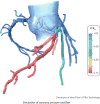Finding the Gatekeeper to the Cardiac Catheterization Laboratory: Coronary CT Angiography or Stress Testing?
- PMID: 26112200
- PMCID: PMC4618380
- DOI: 10.1016/j.jacc.2015.04.060
Finding the Gatekeeper to the Cardiac Catheterization Laboratory: Coronary CT Angiography or Stress Testing?
Abstract
Functional capacity is a robust predictor of clinical outcomes, and stress testing is used in current practice paradigms to guide referral to invasive coronary angiography. However, invasive coronary angiography is driven by ongoing symptoms, as well as risk of adverse outcomes. The limitations of current functional testing-based paradigms might be avoided by using coronary computed tomographic angiography (CCTA) for exclusion of obstructive coronary artery disease. The growth of CCTA has been supported by comparative prognostic evidence with CCTA and functional testing, as well as radiation dose reduction. Use of CCTA for physiological evaluation of coronary lesion-specific ischemia may facilitate evaluation of moderate stenoses, designation of the culprit lesion, and prediction of benefit from revascularization. The potential of CCTA to serve as an effective gatekeeper to invasive coronary angiography will depend, in part, on the adoption of these new developments, as well as definition of the benefit of detecting high-risk plaque for guiding the management of selected patients.
Keywords: angina; atherosclerotic; cardiac catheterization; chest pain; coronary artery disease; coronary computed tomography; plaque.
Copyright © 2015 American College of Cardiology Foundation. Published by Elsevier Inc. All rights reserved.
Figures






Comment in
-
Living Up to the PROMISE: Is There an Ultimate Winner?J Am Coll Cardiol. 2015 Nov 17;66(20):2267-2268. doi: 10.1016/j.jacc.2015.08.887. J Am Coll Cardiol. 2015. PMID: 26564610 No abstract available.
-
Reply: Living Up to the PROMISE: Is There an Ultimate Winner?J Am Coll Cardiol. 2015 Dec 15;66(23):2684-2685. doi: 10.1016/j.jacc.2015.10.006. J Am Coll Cardiol. 2015. PMID: 26670075 No abstract available.
References
-
- Gibbons RJ, Balady GJ, Beasley JW, et al. ACC/AHA Guidelines for Exercise Testing: a report of the American College of Cardiology/American Heart Association Task Force on Practice Guidelines (Committee on Exercise Testing) J Am Coll Cardiol. 1997;30:260–311. - PubMed
-
- Shaw LJ, Hachamovitch R, Berman DS, et al. for the Economics of Noninvasive Diagnosis (END) Multicenter Study Group The economic consequences of available diagnostic and prognostic strategies for the evaluation of stable angina patients: an observational assessment of the value of precatheterization ischemia. J Am Coll Cardiol. 1999;33:661–9. - PubMed
-
- Patel MR, Dai D, Hernandez AF, et al. Prevalence and predictors of nonobstructive coronary artery disease identified with coronary angiography in contemporary clinical practice. Am Heart J. 2014;167:846–52.e2. - PubMed
-
- Lin GA, Dudley RA, Lucas FL, Malenka DJ, Vittinghoff E, Redberg RF. Frequency of stress testing to document ischemia prior to elective percutaneous coronary intervention. JAMA. 2008;300:1765–73. - PubMed
Publication types
MeSH terms
Grants and funding
LinkOut - more resources
Full Text Sources
Other Literature Sources
Medical

